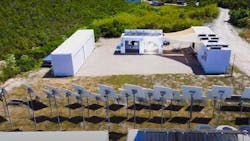Heliostats, Mirrors Offer Evaporative Heating Potential
As readers of this column know by now, sharing innovative technologies that in some way improve sustainability is a regular focus. In the interests of full disclosure and transparency, this one is close to home.
Our firm recently had the opportunity to partner with LightManufacturing (LM), a California-based manufacturer of heliostats and heliostat-based solar rotomolding systems used to mold durable plastic parts. LM holds several patents for its processes, which the firm developed to help suppliers meet the demand for sustainable plastic products.
Traditional plastic molders were using highly polluting processes that emitted millions of pounds of greenhouse gases, and LM’s zero-carbon emissions technology represents the first break-through improvement in 50 years.
According to LM CEO Karl von Kries, “Heliostats offer huge opportunities to decarbonize industrial processes on a global scale, but their potential has so far largely been misunderstood. Heliostat arrays are well-known as the heat source for large power tower systems.”
NOTE: A recent Clark’s Remarks highlighted the use of heliostats to provide heat in the production of synthetic fuels.
“Sun-tracking mirrors have far greater potential in smaller scale, mid-temperature applications,” notes von Kries. “Small to mid-size heliostat arrays enable plastic molding, evaporation acceleration, agricultural drying and processing, desalination, and many other industrial processes that are hard to decarbonize by other methods.”
One such application, that our firm and LM are pursuing is the use of heliostats to enhance the evaporation of brine water in engineered impoundments/ponds. The evaporation rate is directly proportional to air and water temperatures, so an increase in those temperatures increases the rate of evaporation.
Using solar energy, this approach is both carbon- and pollutant-free, since there is no external power required (the only energy consuming components are the controls and motors associated with the axial motions of the mirrors, and those are powered by on-board solar PV). Operational expenses are relatively low, since they are limited to labor and mobilization costs.
Although our firms teamed to propose a specific solution for a single client, the approach is viable for any requirement to increase evaporation of stored or standing water without the use of standard mechanical evaporator/mister (aerosol) technologies, that require mitigation of overspray.
Initial investigations have demonstrated that a single heliostat with a 4-ft-x-6-ft mirror, directly targeting the water with a minimum 50 degree angle of incidence, could – in the southwestern U.S. location provided by the client – provide 2,730 Btuh of additional evaporative heating to the surface of the water. Depending on the size of the pond, an array of hundreds of heliostats could be deployed, providing a significant amount of heat.
The downside of this solution is a slight loss of power midday, when the sun is largely vertical (overhead). That results in the effective mirror size, since it is also largely vertical, being reduced. The good news is that at solar noon, the pond is already getting ‘best heat’ from natural light and the heliostat will provide enhanced morning and afternoon heating, resulting in a higher evaporation rate.
The jury is still out here on our contemplated project, but I have to confess that I am excited about the potential of using heliostats for other heating applications in which solar energy probably had never even been considered.
####
A contributor to HPAC Engineering since 2013 and a member of its Editorial Advisory Board, the author is a proud Virginia Tech alum, and a principal at Sustainability Performance Solutions LLC, a south Florida-based engineering firm focused on energy efficiency and sustainability. He can be reached at [email protected].
